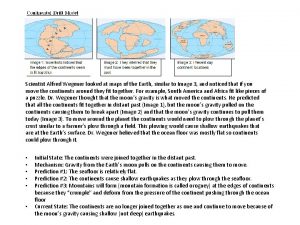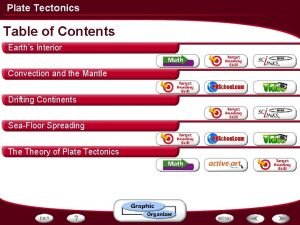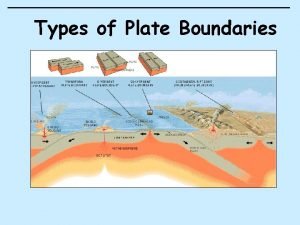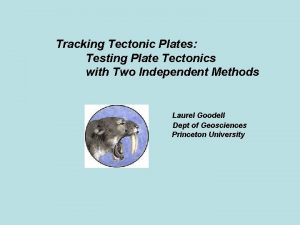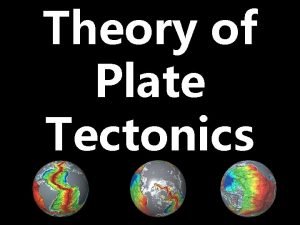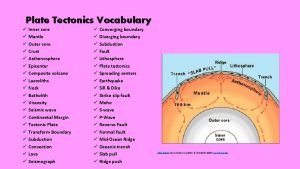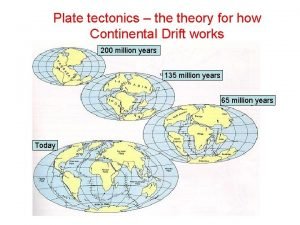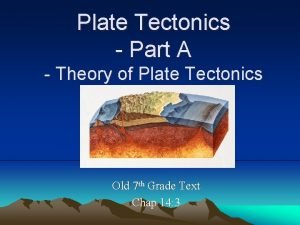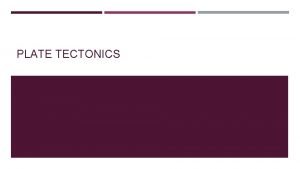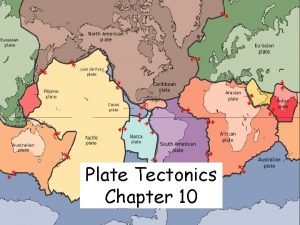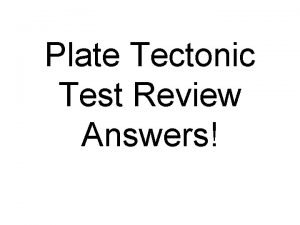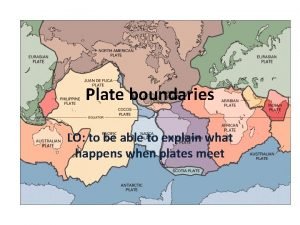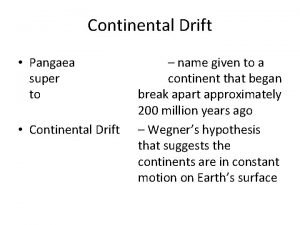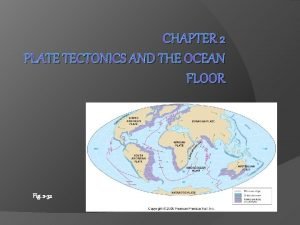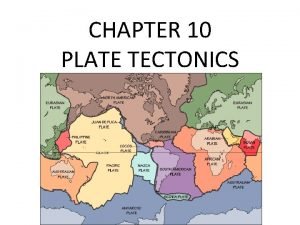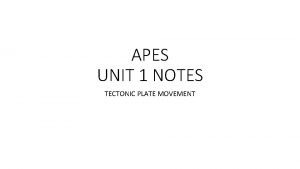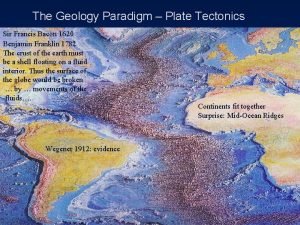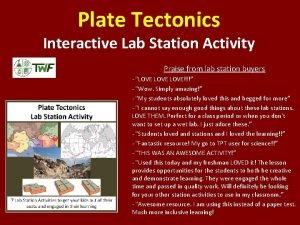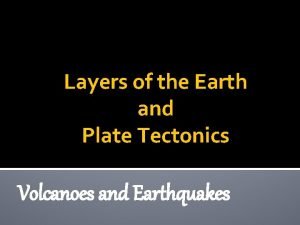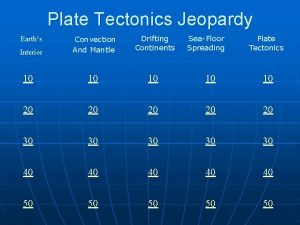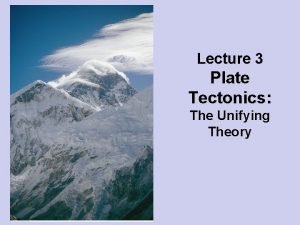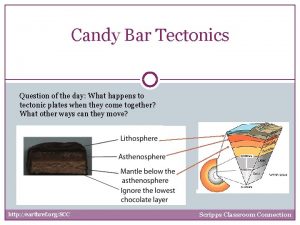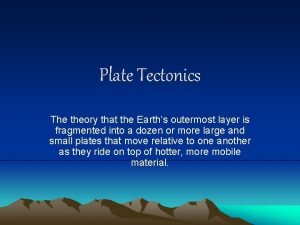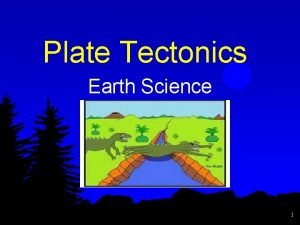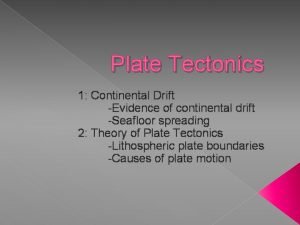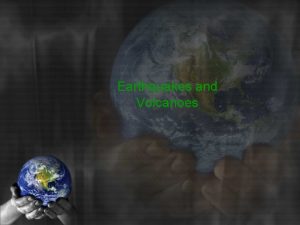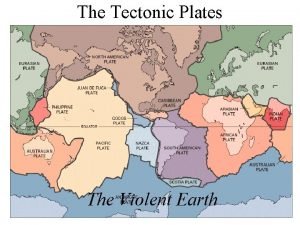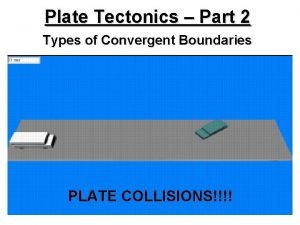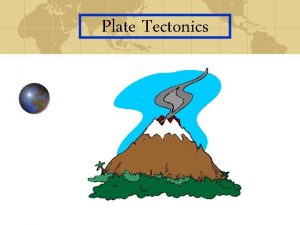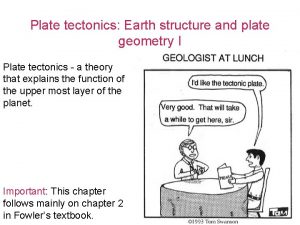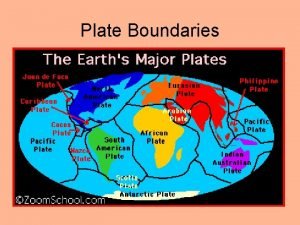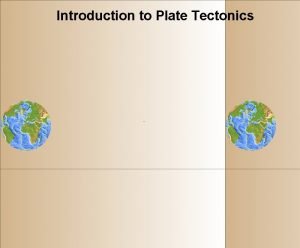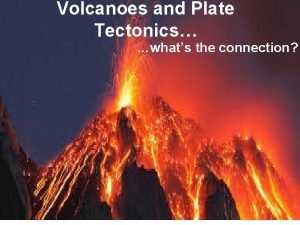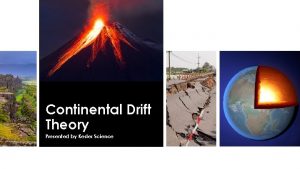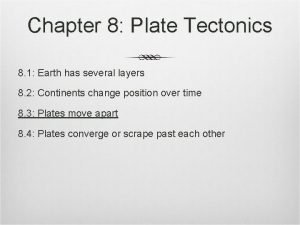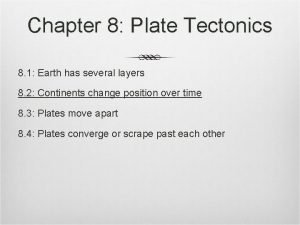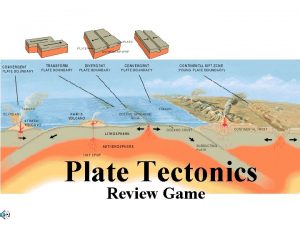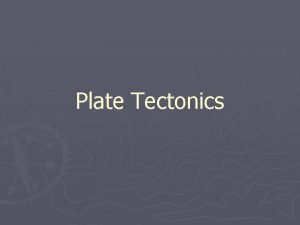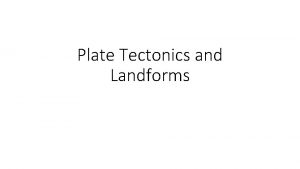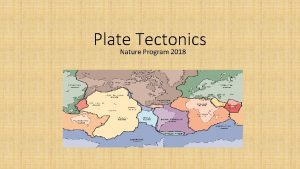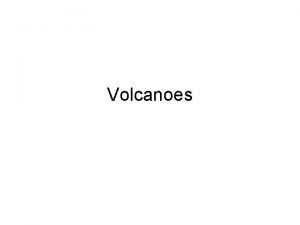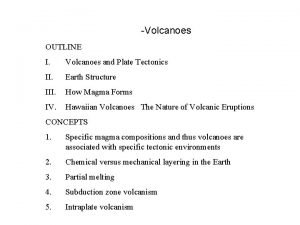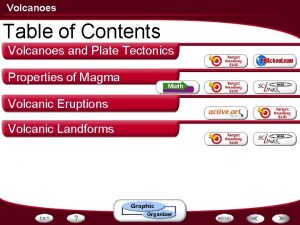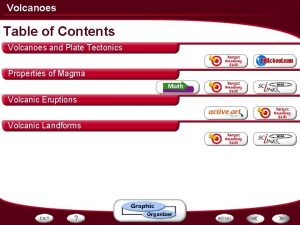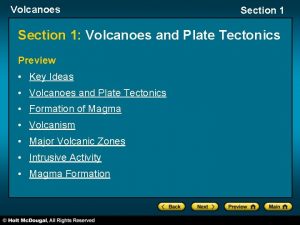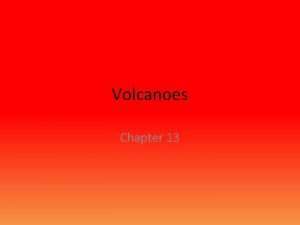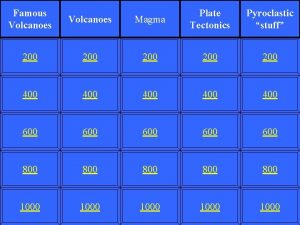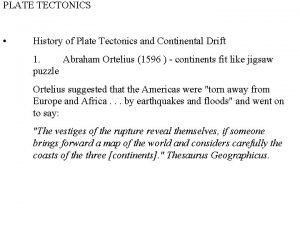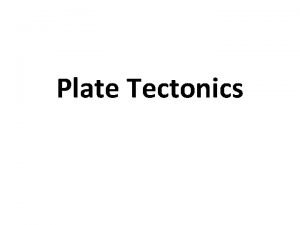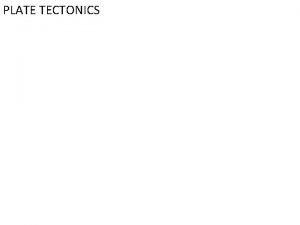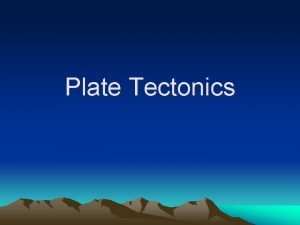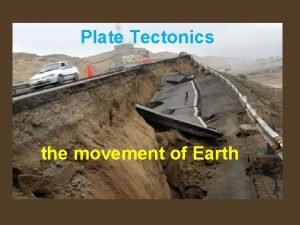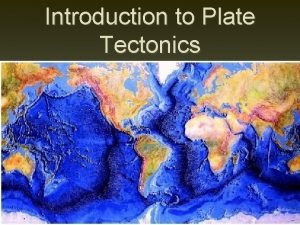Volcanoes and Plate Tectonics whats the connection GUIDED
















































- Slides: 48

Volcanoes and Plate Tectonics… …what’s the connection?

GUIDED READING QUESTIONS 5. What are volcanoes? 6. Describe the different types of volcanic eruptions and their effects. 7. Contrast explosive acid and basaltic volcanic eruptions. 8. Describe some real-world examples of volcanic eruptions (Pinatubo – LEDC, Etna, Unzun – MEDC). 9. Analyze the following volcanic hazards: a. tsunamis b. landslides c. ground deformation d. volcanic ash /lava/hot ash clouds (nuee ardentes) 10. Evaluate the effectiveness of the following strategies to limit damage and loss of life due natural hazards (earthquakes and volcanoes): a. historic records (e, v) b. frequency (e, v) c. seismic evidence (e, v) d. tilt metres (v) e. chemical analysis (v) f. building design (e) g. rescue and aid (e, v)

GR #5

Pacific Ring of Fire Volcanism is mostly focused at plate margins

Volcanoes • How do volcanoes relate to plate tectonics? • Why are some volcanoes more dangerous than others?

Where do they occur? Tectonic Settings • Convergent bounda ries – Subduction zones Cut and paste diagram into notes • Divergent boundarie s • Intraplate (hot spots )

Where do Volcanoes Occur in USA?

Volcanoes and the Earth System Affect Earth’s Spheres Affect Climate • Origin of atmosphere and oceans via outgassing • Mass extinctions Ø K-T boundary – 65 • Gases and particles million years ago – demise of the dinos Ø Volcanism and/or asteroid? Ø Tambora 1815 – followed by “year without a summer” Ø Pinatubo, 1991: sulfuric acid formed aerosols; cooled temperatures in some areas by as much 0. 5 degrees C • Volcanoes emit CO 2

VIDEO: Origin of Earth’s Atmosphere & Oceans




Did you know… ”The Scream” Edvard Munch Painted in 1893 based on Munch’s memory of the brilliant sunsets following the 1883 Krakatau eruption. Alan Robock, Rutgers University

Structure of a GR #6 Volcano • an opening in the earth’s crust from which materials are ejected • during eruption, molten rock or magma is ejected onto the earth’s surface as lava • gases are released in atmosphere

READING: Types of Volcanoes Read the article of the three main types of volcanoes and complete the data table below. Shield Composition Type of Eruption Examples Cinder Cone Composite

Types of Volcanoes



Example of Hot Spot Volcanoes Hawaii

What controls the violence of an eruption?

Volcanic eruptions Viscosity of magma – factors • Temperature (hotter magmas are less viscous) • Composition [Si 02 (silica) content] • High silica – high viscosity (e. g. , rhyolitic lava) • Low silica – more fluid (e. g. , basaltic lava) • Dissolved gases (volatiles) • Mainly water vapor and carbon dioxide • Gases expand near the surface More silica = more linkage = more viscous

Magma Compositions Affect Properties Source: USGS


GR #7

Explosive Eruptions • Explosive volcanic eruptions can be catastrophic Hazardous!!! • Erupt 10’s-1000’s km 3 of magma • Send ash clouds >25 km into the stratosphere • Have severe environmental and climatic effects Mt. Redoubt Above: Large eruption column and ash cloud from an explosive eruption at Mt Redoubt, Alaska

Explosive Eruptions What is produced? • Ash fall • Pyroclastic flow • Pyroclastic surge Pyroclastic flows on Montserrat, buried the capital city.


Direct measurements of pyroclastic flows are extremely dangerous!!

Effusive Eruptions • Effusive eruptions are characterized by outpourings of lava on to the ground. Hawaii Courtesy of www. swisseduc. ch

Volcanic Hazards • • • Courtesy of www. swisseduc. ch Pyroclastic flow Lahars/Mud flows Pyroclastic fall Lava flow Noxious Gas Earthquakes

Pyroclastic Flow • For example, eruption of Vesuvius in 79 AD destroyed the city of Pompeii • Pyroclastic flows of poisonous gas and hot volcanic debris engulfed the cities of Pompeii, Herculaneum and Stabiae suffocating the inhabitants and burying the buildings.

On August 24, 79 AD Mount Vesuvius literally blew its top, erupting tonnes of molten ash, pumice (volcanic rock that contains many vesicles/bubbles) and sulfuric gas miles into the atmosphere. • The photo on the left shows a more recent eruption of Vesuvius, but this is the kind of thing people living in Pompeii would have seen at the time. The photo on the right shows the remains of an inhabitant of Pompeii with the Vesuvius volcano in the background.

Recovery after Eruption…. • The cities remained buried and undiscovered for almost 1700 years until excavation began in 1748. These excavations continue today and provide insight into life during the Roman Empire.

Vesuvius Today • Vesuvius remains a hazardous volcano with heavily populated flanks: Naples Vesuvius Bay of Naples Courtesy of www. swisseduc. ch – around 1. 5 million people live in the city of Naples alone – Naples is situated approx. 30 km from Vesuvius – Pyroclastic flows can flow up to 100 km from source!

Pyroclastic Flow - Direct impact Courtesy of www. swisseduc. ch

Pyroclastic Flow - Burial

Pyroclastic Flow - Burns

Pyroclastic Flow - Lahars • Hot volcanic activity can melt snow and ice • Melt water picks up rock and debris • Forms fast flowing, high energy torrents • Destroys all in its path

Pyroclastic Fall Ash load • Collapses roofs • Brings down power lines • Kills plants • Contaminates water supplies • Respiratory hazard for humans and animals

Lava Flow • It is not just explosive volcanic activity that can be hazardous. • Effusive (lava) activity is also dangerous.

Case Study: Lava Flow Heimaey, Iceland • January 23, 1973 • Large fissure eruption threatened the town of Vestmannaeyjar

Stopping the Lava Flow Heimaey, Iceland • However, the potential damage was reduced by spraying seawater onto the advancing lava flows. • This caused them to slow and/or stop, or diverted them away from the undamaged part of the town.

f o k s i r e h t e z i m i n i m ? e s w e o o n d a c l o v How e v i t ac

Volcano Monitoring • observatories are set up on all active volcanoes that threaten the human population • designed to monitor and potentially to predict the eruptive behavior of the volcano in question

Precursors to Eruption • Seismicity – Increased earthquakes in area • Deformation – Swelling/crackin g of the ground • Gas Output – (on volcano and remote sensing techniques) These three things are the most important precursors to an eruption.

Seismic Activity • Earthquake activity commonly precedes an eruption – Result of magma pushing up towards the surface – Increase volume of material in the volcano shatters the rock – This causes earthquakes

Deformation Monitoring • Tilltmeters can tell you when new material enters the magma chamber. A B Note the presence of earthquakes in relation to the deformation. Often it is a combination of events that fore -warns of an eruption.

Gas Monitoring • Commonly gas output from a volcano increases or changes composition before an eruption. – As magma rises to the surface it releases (exsolves) much of its gas content. – This can be measured
 Continental drift theory and plate tectonics theory
Continental drift theory and plate tectonics theory Compare continental drift and plate tectonics
Compare continental drift and plate tectonics Mantle convection and plate tectonics
Mantle convection and plate tectonics Continental drift vs plate tectonics
Continental drift vs plate tectonics Oreo tectonics
Oreo tectonics Oreo plate tectonics
Oreo plate tectonics Plate tectonics vs continental drift
Plate tectonics vs continental drift 4 plate boundaries
4 plate boundaries Plate motion calculator
Plate motion calculator The plate tectonics theory states that
The plate tectonics theory states that Plate tectonics webquest answers
Plate tectonics webquest answers Plate tectonics vocabulary
Plate tectonics vocabulary Continental drift
Continental drift Plate tectonics definition
Plate tectonics definition Driving force of plate tectonics
Driving force of plate tectonics Concept map plate tectonics
Concept map plate tectonics Summarize the theory of plate tectonics
Summarize the theory of plate tectonics Harry hess and seafloor spreading
Harry hess and seafloor spreading Mantle magma
Mantle magma Tectonic plate movement
Tectonic plate movement A plate tectonics puzzle worksheet answer key
A plate tectonics puzzle worksheet answer key From now
From now Chapter 10 plate tectonics
Chapter 10 plate tectonics Plate boundaries apes
Plate boundaries apes Francis bacon plate tectonics
Francis bacon plate tectonics Plate tectonics interactive lab
Plate tectonics interactive lab Oreo plate tectonics
Oreo plate tectonics Tectonic plates lyrics
Tectonic plates lyrics Types of volcanoes
Types of volcanoes Plate tectonics game board
Plate tectonics game board Unifying theory of plate tectonics
Unifying theory of plate tectonics Candy bar tectonics
Candy bar tectonics Plate tectonics
Plate tectonics Tectonic plates
Tectonic plates Plate tectonics
Plate tectonics Plate tectonics
Plate tectonics Map of plate tectonics
Map of plate tectonics Boundaries of plate tectonics
Boundaries of plate tectonics Juan de fuca plate
Juan de fuca plate Earth rotation
Earth rotation Future plate tectonics
Future plate tectonics Theory of plate tectonics
Theory of plate tectonics Strombolian eruption
Strombolian eruption Layers of the earth jeopardy
Layers of the earth jeopardy Continental drift theory
Continental drift theory Chapter 8 plate tectonics
Chapter 8 plate tectonics Chapter 8 plate tectonics
Chapter 8 plate tectonics Text to text connections examples
Text to text connections examples Bolted connection
Bolted connection

